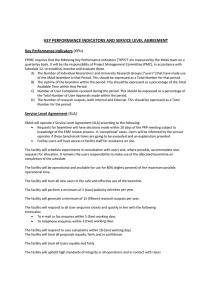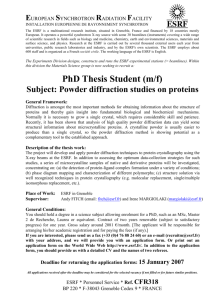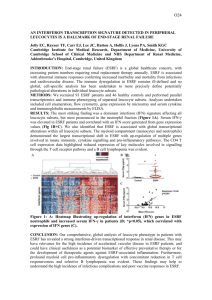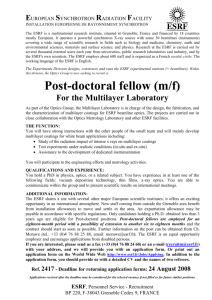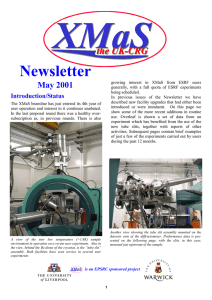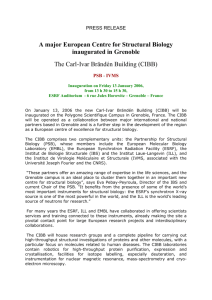XMaS takes the strain off Moore’s law
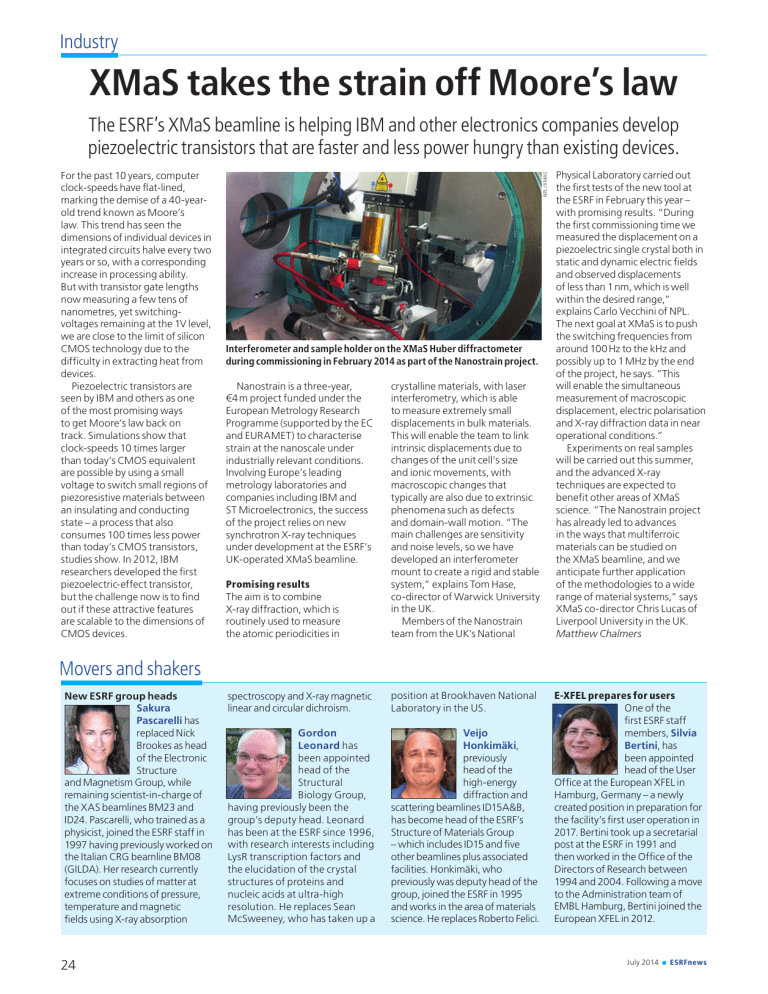
Industry
XMaS takes the strain off Moore’s law
The ESRF’s XMaS beamline is helping IBM and other electronics companies develop piezoelectric transistors that are faster and less power hungry than existing devices.
For the past 10 years, computer clock-speeds have fl at-lined, marking the demise of a 40-yearold trend known as Moore’s law. This trend has seen the dimensions of individual devices in integrated circuits halve every two years or so, with a corresponding increase in processing ability.
But with transistor gate lengths now measuring a few tens of nanometres, yet switchingvoltages remaining at the 1V level, we are close to the limit of silicon
CMOS technology due to the diffi culty in extracting heat from devices.
Piezoelectric transistors are seen by IBM and others as one of the most promising ways to get Moore’s law back on track. Simulations show that clock-speeds 10 times larger than today’s CMOS equivalent are possible by using a small voltage to switch small regions of piezoresistive materials between an insulating and conducting state – a process that also consumes 100 times less power than today’s CMOS transistors, studies show. In 2012, IBM researchers developed the fi rst piezoelectric-effect transistor, but the challenge now is to fi nd out if these attractive features are scalable to the dimensions of
CMOS devices.
Interferometer and sample holder on the XMaS Huber diffractometer during commissioning in February 2014 as part of the Nanostrain project.
Nanostrain is a three-year,
€4 m project funded under the
European Metrology Research
Programme (supported by the EC and EURAMET) to characterise strain at the nanoscale under industrially relevant conditions.
Involving Europe’s leading metrology laboratories and companies including IBM and
ST Microelectronics, the success of the project relies on new synchrotron X-ray techniques under development at the ESRF’s
UK-operated XMaS beamline.
Promising results
The aim is to combine
X-ray diffraction, which is routinely used to measure the atomic periodicities in crystalline materials, with laser interferometry, which is able to measure extremely small displacements in bulk materials.
This will enable the team to link intrinsic displacements due to changes of the unit cell’s size and ionic movements, with macroscopic changes that typically are also due to extrinsic phenomena such as defects and domain-wall motion. “The main challenges are sensitivity and noise levels, so we have developed an interferometer mount to create a rigid and stable system,” explains Tom Hase, co-director of Warwick University in the UK.
Members of the Nanostrain team from the UK’s National
Physical Laboratory carried out the fi rst tests of the new tool at the ESRF in February this year – with promising results. “During the fi rst commissioning time we measured the displacement on a piezoelectric single crystal both in static and dynamic electric fi elds and observed displacements of less than 1 nm, which is well within the desired range,” explains Carlo Vecchini of NPL.
The next goal at XMaS is to push the switching frequencies from around 100 Hz to the kHz and possibly up to 1 MHz by the end of the project, he says. “This will enable the simultaneous measurement of macroscopic displacement, electric polarisation and X-ray diffraction data in near operational conditions.”
Experiments on real samples will be carried out this summer, and the advanced X-ray techniques are expected to benefi t other areas of XMaS science. “The Nanostrain project has already led to advances in the ways that multiferroic materials can be studied on the XMaS beamline, and we anticipate further application of the methodologies to a wide range of material systems,” says
XMaS co-director Chris Lucas of
Liverpool University in the UK.
Matthew Chalmers
Movers and shakers
New ESRF group heads
Sakura
Pascarelli has replaced Nick
Brookes as head of the Electronic
Structure and Magnetism Group, while remaining scientist-in-charge of the XAS beamlines BM23 and
ID24. Pascarelli, who trained as a physicist, joined the ESRF staff in
1997 having previously worked on the Italian CRG beamline BM08
(GILDA). Her research currently focuses on studies of matter at extreme conditions of pressure, temperature and magnetic fi elds using X-ray absorption spectroscopy and X-ray magnetic linear and circular dichroism.
Gordon
Leonard has been appointed head of the
Structural
Biology Group, having previously been the group’s deputy head. Leonard has been at the ESRF since 1996, with research interests including
LysR transcription factors and the elucidation of the crystal structures of proteins and nucleic acids at ultra-high resolution. He replaces Sean
McSweeney, who has taken up a position at Brookhaven National
Laboratory in the US.
Veijo
Honkimäki , previously head of the high-energy diffraction and scattering beamlines ID15A&B, has become head of the ESRF’s
Structure of Materials Group
– which includes ID15 and fi ve other beamlines plus associated facilities. Honkimäki, who previously was deputy head of the group, joined the ESRF in 1995 and works in the area of materials science. He replaces Roberto Felici.
E-XFEL prepares for users
One of the fi rst ESRF staff members, Silvia
Bertini , has been appointed head of the User
Offi ce at the European XFEL in
Hamburg, Germany – a newly created position in preparation for the facility’s fi rst user operation in
2017. Bertini took up a secretarial post at the ESRF in 1991 and then worked in the Offi ce of the
Directors of Research between
1994 and 2004. Following a move to the Administration team of
EMBL Hamburg, Bertini joined the
European XFEL in 2012.
24
ESRFJul14INDUSTRY-MOVERS-p24-4.indd 24
July 2014
●
ESRFnews
18/06/2014 15:30
